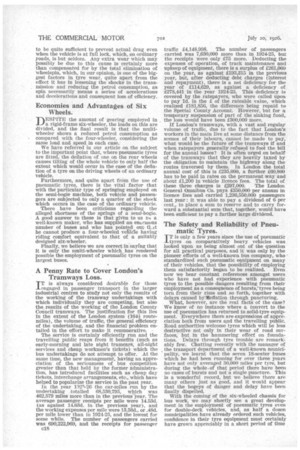Economies and Advantages of Six Wheels.
Page 2

If you've noticed an error in this article please click here to report it so we can fix it.
JJESPITE the amount of gearing employed in a rigid-frame six-wheeler, the loads on this are divided, and the final result is that the multiwheeler shows a reduced petrol consumption as compared with the four-wheeler, considering the same load and speed in each case. We have referred in our article on the subject to the important point that, where pneumatic tyres are fitted, the deflation of one on the rear wheels causes tilting of the whole vehicle to only half the extent which would occur in the case of the deflation of a tyre on the driving wheels of an ordinary vehicle.
Furthermore, and quite apart from the use of pneumatic tyres, there is the vital factor that with the particular type of springing employed on the semi-bogie machine, both vehicle and passengers are subjected to only a quarter of the shock which occurs in the case of the ordinary vehicle. There have been criticisms regarding the alleged shortness of the springs of a semi-bogie. A good answer to these is that given to us nv a well-known maker, who has supplied an enormous number of buses and who has pointed out tlit he cannot produce a four-wheeled veMcle having riding comfort equivalent to that of a suitably designed six-wheeler, Finally, we believe we are correct in saying that It is only the multi-wheeler which_ has rendered possible the employment of pneumatic tyres on the largest buses.






























